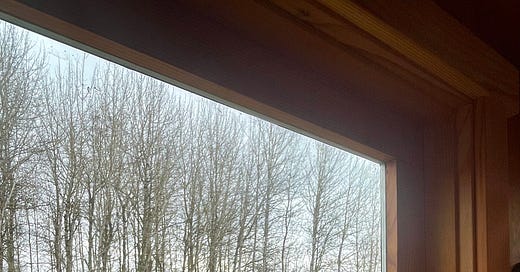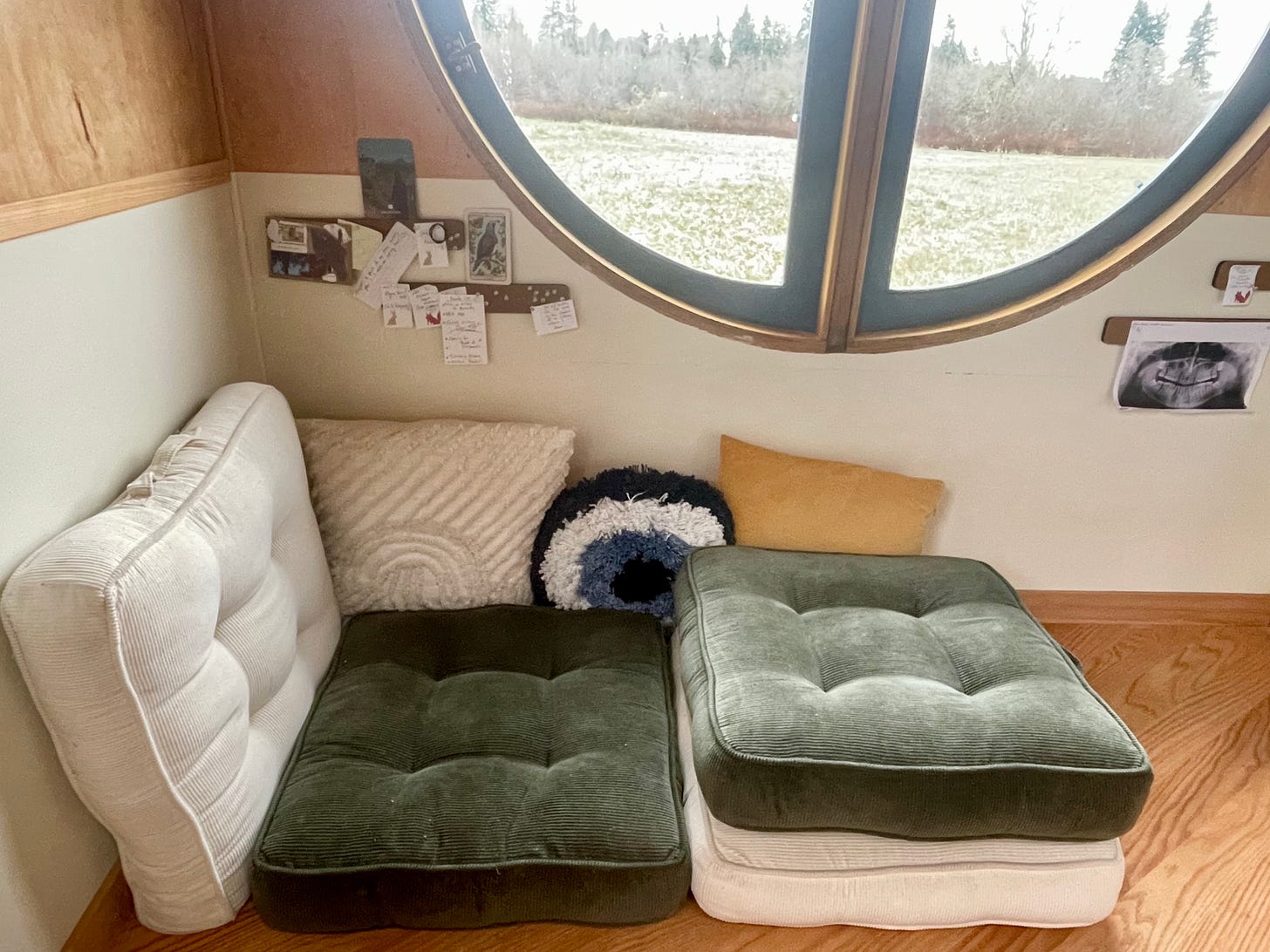Reclaiming Autonomy in Creative Practice
how to make the page a refuge (and reject your inner fascist)
Big News! This month we are launching paid subscriptions. Free subscribers will still get essays in your inbox! Paid subscribers will also get a bonus prompt twice a month to help you build your relationship to joyful practice through writing and reflection—and whatever other forms you choose. If there are other types of content you’d like to see from us, please let us know!
There was a time in my life, not long ago, that I had far less autonomy than I needed. I was raising two young kids who—you know how it goes—were always on me, drooling, needing things like nose wipes and diaper changes and milk from my body. I was also working a job, one that required me to grade mountains of papers and be accountable to, over the course of a year, hundreds of students and colleagues. That was too many people for me. I hadn’t yet considered my own neurodivergence. I thought I just needed to try harder.
When I think of those years, they’re a blur of too much and not enough. Too many demands, not enough freedom. Too much noise, not enough quiet. Too much work, not enough play. I went into functional freeze and I stayed there for years.
When my younger son was about four years old, he said to me “When I grow up, I’m not going to sign up for a job.” It was such a reasonable statement, and I could tell that it was informed by his sense of how adults moved through the world, in constant relation to money and demands. He did not want a life of all work and no play and, more importantly, he didn’t see this as inevitable.
Lately, my parenting journey has immersed me in the world of neurodivergence in general, and the PDA profile of Autism in particular. PDA, by its original definition, stands for Pathological Demand Avoidance, but many in the PDA community think that Persistent Drive for Autonomy captures it better. PDA is sometimes described as a nervous system disability because any perceived loss of autonomy (put on your shoes, for instance, or complete these 10 math problems, or clean your room now or I’ll take away screen time) is a direct stress to the PDA nervous system. Pile these demands on each other day after day—which is pretty much what childhood is—and you get a kid who is constantly in fight, flight, or freeze.
When I first started learning about PDA, I marveled at how strange it was—how was it that someone’s nervous system could be wired for such a specific trigger? Why autonomy? At first it seemed a random as being triggered by the sight of carrots or a discarded sock. But the longer I’ve sat with it, the more I’ve observed my own reaction to demands (a steadily creeping dread), the more my child’s nervous system makes sense to me.
Sometimes, I think about tickling— the specific way I felt as a child when someone tickled me for fun. At first, the attention was a delight. But, only seconds later it was too much. I would cry out for the adult to stop, while hanging onto fear that they wouldn’t. What I felt was a full-body panic over the loss of my autonomy, a fear of being suffocated by my own involuntary laughter. This full-body panic is, I think, is what my child feels much of the time.
I’ve come to believe that the nervous system—all nervous systems—loves autonomy, that our thriving depends on our empowerment, our ability to walk through the world on our own terms. When our autonomy is compromised by the demands of daily living, we can survive but our experience of joy, pleasure, and life force is limited. It’s like trying to experience the ocean by sucking it through a straw. That’s what I felt in my years of functional freeze. I’m guessing you’ve felt that way too.
I’ve also come to believe that autonomy is the magical force that draws us to make art; it’s the reason so many of us sensitive souls—the queers, the neurodivergents, the marginalized, the invisible—turn to writing and art-making. The page is the place where we get to make the world. It’s the place where we get to practice understanding ourselves and our stories, the place where we won’t be interrupted, where no one can step in and change the narrative. When I’m writing, no one misunderstands me. When I’m writing, I get to feel the things I couldn’t fully feel when they were happening. The autonomy of art-making is exactly where the healing is.
Except, it’s not quite that simple. When we show up to write, we bring plenty of voices with us—relics and values from the very world we’re tying to remake. I’m sure you have a set of voices that’s unique to you, but I can try to capture the ones who talk to me.
There’s the supervisor voice, deeply invested in capitalism, who wants me to make a product with some kind of measurable value and not waste my time on fun experiments.
There’s the insecure voice, the shrill ego, who desperately wants what I write to be good and original right away.
There’s the chorus of anonymous editors who have rejected my work over the years, especially the one who returned my work to me with a single word, hand-written on the first page, “No.”
There’s my high school history teacher, Mr. McGovern, who gave me Cs on my papers no matter how hard I tried, with no feedback to help me understand where I was going wrong. I figured I was just a C writer.
There’s my perception of what it should mean to be a writer: A writer is someone who sits at a clean desk with the internet off for hours at a time and gets lost in his work. A writer is someone who can stay up until 3 am every night for weeks just to finish a draft. A writer is someone who can ignore the dishes and the laundry and hunger cues and all other basic needs because the work is so essential. A writer has no need for rest or self-care.
It's this last piece, in fact, that’s been the most distracting—the most damaging. But all of the voices have, in their own way, withheld from me the autonomy I’ve sought through writing practice.
For me, healing hasn’t meant banishing the voices. That would be impossible. It has meant learning to get real quiet and listen for the voice among voices that is actually me. It has meant deciding that:
What I want is relevant.
How my brain wants to work is relevant.
Finding pleasure in the work is relevant.
Joyful practice is autonomous practice; it’s not dictated by any external vision or expectation of what your work or your practice should look like. Or rather, it’s about learning to live in relation to the voices, rather than in submission to them.
These days, I focus on loving my brain instead of fighting it. Building a practice that fits me has included:
Noticing and accepting that I need total silence to concentrate
Creating a physical space that feels special to me (not a desk! I write cross-legged in a cozy nook on the floor)
Noticing and accepting that, when facing a blank page, I like to work in 20-minute increments (not hours!)
Noticing that collaboration with friends infuses joy into my work—and my life!
Noticing that if I take time daily for creative practice, my body and brain retain a kind of openness the rest of the day.
Treating writing as an act of slowing down and taking dictation from my brain— stammers, gaps, and all
I have come to find myself, finally, in a reciprocal relationship with my creative self—a self who is actually me and not Cormac McCarthy or David Foster Wallace, or whatever dude I was imagining when I was trying to mold myself into a different kind of writer—the kind who might earn imaginary approval but bring me no real joy. The notions of discipline that I’ve been fed through school and writing community discourse distracted me from what actual creative practice can look like. It turns out that I didn’t need an external set of rules; I didn’t need discipline; I needed to locate my inner compass.
Prompts for your own Joyful Practice:
What are the voices or relics that crowd your creative practice?
What are some ways you can bring safety and pleasure to your practice? (You might ask your body this question and see how it answers.)
What conditions does your brain like best? (Consider time of day, length of time, sensory input, etc.)
Comments are open below and we’d love to hear from you!







What a beautiful post, Jen! Like you, I have to have abject silence in order to anything creative. What is that? So many people have headsets on, or are listening to music, or literally cannot work without some kind of auditory stimulation going on in the background. This drives me INSANE. I have to totally shut myself away. Love your writing studio! What a lovely nest, so conducive to creativity.
And I love that you don't have a desk there. I also have a twin bed in my office because there are so many times I don't want to type at all, but I want to gaze out at clouds through this window the bed faces. I just need to do nothing. Artists must have moments where they are absolutely doing nothing, or at least I do. And I especially loved that you brought up collaboration. This is weird, because I don't know that many writers who do stuff like co-authorship, but I always felt this was not only fun, but creatively stimulating. If you're paired with a person who is like-minded but different enough to challenge you, to bounce ideas off you, to meld with you, it's like some kind of heaven has been brought about. I don't see writers writing in collaboration so much, but it's honestly my preference. I'm working right now on a new story -- maybe a novel someday -- that is fictional, and I'm writing in a vacuum so to speak; that is, by myself. And some amazing stuff is coming forth, but honestly, I miss writing with a partner. So this post really resonated with me.
I loved reading this. I’ve always wanted to just live a life filled with play and joyful work. Through Zen practice I learned that this is attainable to all who are prepared to work on their mind. But now that I have a child, it’s much harder to remember that. Thank you for the reminder❤️